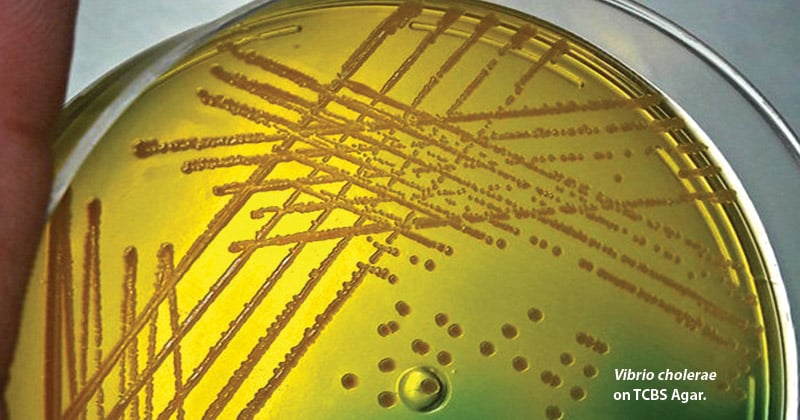Thiosulfate-citrate-bile salts-sucrose (TCBS) Agar, is a type of selective agar that is used in microbiology laboratories to isolate Vibrio species. TCBS Agar is a selective differential medium for isolating and cultivating Vibrio cholerae and other Vibrio species from clinical specimens and other materials. TCBS Agar was developed by Kobayashi et al, who modified the selective medium of Nakanishi. Although this medium was originally designed for the isolation of V. cholerae and V. parahaemolyticus, most Vibrios grow to healthy large colonies with different colonial morphologies.
Interesting Science Videos
Composition of TCBS Agar
| Ingredients | Grams/liter |
| Proteose peptone | 10.0 |
| Yeast extract | 5.0 |
| Sodium thiosulphate | 10.0 |
| Sodium citrate | 10.0 |
| Bile | 8.0 |
| Sucrose | 20.0 |
| Sodium chloride | 10.0 |
| Ferric citrate | 1.0 |
| Bromothymol blue | 0.04 |
| Thymol blue | 0.04 |
| Agar | 15.0 |
Final pH ( at 25°C) 8.6±0.2
Principle of TCBS Agar
TCBS Agar is used for the selective isolation of Vibrio cholerae and other enteropathogenic vibrios. Proteose peptone and yeast extract provide nitrogenous compounds, vitamin B complex, and other essential growth nutrients. Bile, a derivative of bile salts and sodium citrate inhibits gram-positive bacteria and coliforms. Sodium thiosulphate serves as a good source of sulphur, which in combination with ferric citrate detects the production of hydrogen sulphide. For the metabolism of Vibrios, sucrose is added as a fermentable carbohydrate. The acidification of the medium resulting from the fermentation of sucrose by Vibrio makes bromthymol blue turn yellow. Bromthymol Blue and Thymol Blue are pH indicators. Sodium chloride provides optimum growth and metabolic activity of halophilic Vibrio spp. Agar is a Solidifying agent. The alkaline pH of the medium improves the recovery of V.cholerae, hence an increased pH is used to enhance the growth of Vibrio cholera.
Preparation TCBS Agar
- Suspend 89.08 gm of dehydrated medium in 1000ml of distilled or deionized water.
- Heat to boiling to dissolve the medium completely.
- Do not autoclave.
- Cool to 45-50°C.
- Mix well and pour into sterile Petri plates.
Result Interpretation on TCBS Agar

| Microorganisms | Characteristics |
| Vibrio cholera | Flat yellow colonies, 2-3 mm in diameter |
| Vibrio alginolyticus | Large yellow colonies |
| Vibrio fluvialis, Vibrio vulnificus | Yellow or translucent colonies |
| Vibrio parahaemolyticus | Colorless colonies with a green center |
| Pseudomonas, Aeromonas | Blue colonies |
| Enterobacteria or others | Tiny transparent colonies |
Uses of TCBS Agar
- TCBS Agar is used for the isolation of Vibrio cholerae and other enteropathologic Vibrio (in particular Vibrio parahaemolyticus) in fish, seafood and biological samples of animal origin.
- They have also been used to control outbreaks of the crown-of-thorns seastar (Acanthaster planci).
Limitations of TCBS Agar
- Due to nutritional variation, some strains may be encountered that grow poorly or fail to grow on this medium. Further tests are necessary for confirmation of Vibrio spp.
- The medium should be inoculated heavily with faecal specimens because growth of few species may be inhibited on the medium due to fermentation of sucrose and accumulation of acids.
- However, occasional isolates of Pseudomonas and Aeromonas may also form blue green colonies on TCBS Agar.
- On initial isolation, V. parahaemolyticus may be confused with Aeromonas hydrophila, Plesiomonas shigelloides, and Pseudomonas spp.
- Sucrose-fermenting Proteus spp. produce yellow colonies which may resemble those of Vibrio.
- TCBS is an unsatisfactory medium for oxidase testing of Vibrio spp.
- A few strains of V. cholerae may appear green or colorless on TCBS Agar due to delayed sucrose fermentation.
- It is recommended that a non-selective media be used in conjunction with selective media for optimum recovery of pathogenic organisms.
- They are highly selective for Vibrio species. Any H2S negative colony of TCBS Agar can be considered presumptive positive for Vibrio. Therefore, further biochemical and serological tests must be carried out for complete identification
References
- HiMedia Laboratories Pvt. Ltd
- Becton, Dickinson and Company
- Sigma-Aldrich, Inc.
- Remel
- Thermo Fisher Scientific Inc.- Dehydrated Culture Media, CHOLERA MEDIUM TCBS (CM0333)
- Hardy Diagnostics
- Wikipedia
- Microbe online
- Atlas R.M and Snyder J.W. 2014. Handbook of Media for Clinical and Public Health Microbiology. CRC Press. Taylor & Francis Group. 6000 Broken Sound Parkway NW, Suite 300 Boca Raton, FL 33487-2742.

I cultured V. anguillarum on my TCBS agar, and I observed both green and yellow colonies on the medium. What could be the reason for this?
vibrio vulnificus yellow or green colonies????